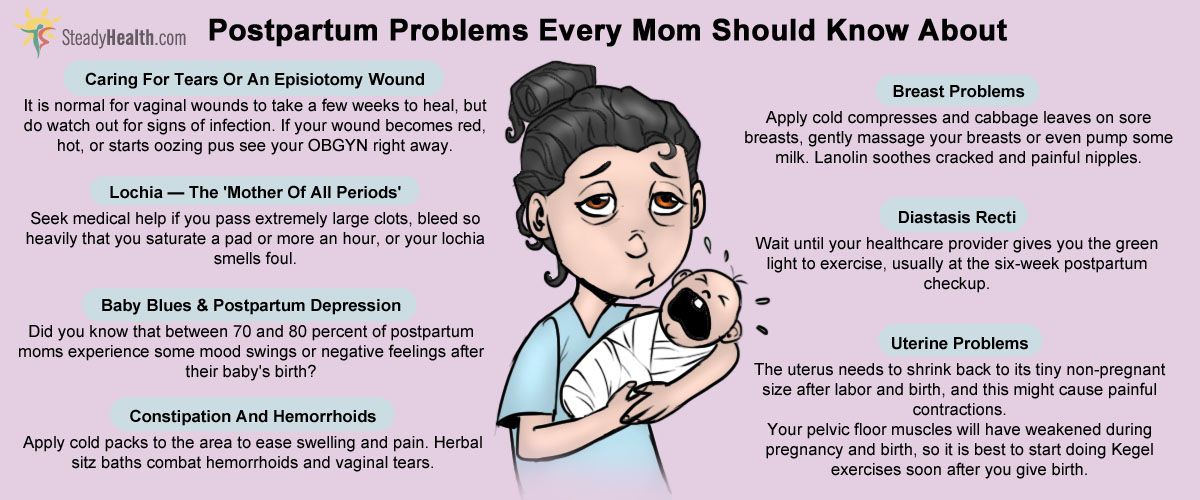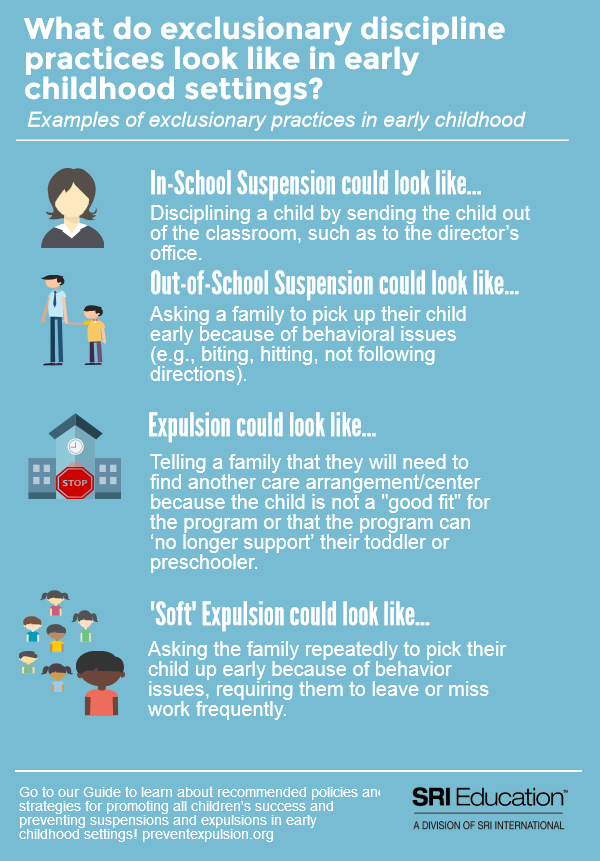How much does it cost to get braces for a child
How Much Do Braces Cost For Kids?
It’s an important question that many parents ask when they find their children need orthodontic care: How much do braces actually cost? While you mostly want the process to be productive and painless, it’s also important to consider the varying costs of braces.
While it’s possible to calculate your payment amounts, many factors contribute to the cost of orthodontics. These include the type of braces, your child’s teeth, your child’s dental hygiene, and your plan of financing. Your total cost for braces may be as low as $3,000, or as high as $8,000. With a little bit of research, you can choose a course of treatment that saves you money, and a financing plan that makes the cost easier to bear. We’ve updated this blog post to give you additional information about the cost of braces for kids, how to budget and what to expect.
How Much Do Braces Cost and How Can You Save?
Type of Braces
There are several different types of braces, and the type that your child needs will impact the total treatment plan and cost of treatment. Some braces, like clear aligners and ceramic braces, are harder to see, while others will take less time. The average cost of braces for kids will vary based on time and type.
- Traditional Metal Braces: Traditional metal braces are the oldest and most common type of braces. The average cost of metal braces is also generally lowest. These braces stand out more than other types, and some children dislike the obvious appearance of metal braces.
- Damon Braces: Damon braces use clear, sliding brackets in lieu of metal brackets. The average cost of Damon Braces is usually higher, but can generally shorten the term of the orthodontic treatment.
- Clear Aligners: Clear aligners, such as Invisalign, seem to be the most visually appealing to many. Clear aligners use a series of trays molded to your teeth to gradually move them into position. Compared to traditional braces, Invisalign are usually the most expensive option for treatment. If only minor corrections are needed, Invisalign may be a cost-effective option.

- Ceramic Braces: While traditional braces use metal and clear aligners use plastic, ceramic braces use ceramic material to align teeth. Ceramic braces may work slower than metal braces and the total cost of treatment may be higher.
- Lingual Braces: Lingual braces work similarly to traditional metal braces, except they are attached to the inside of teeth. This means they are out of sight, but they can make major corrections like traditional braces.
Don’t be afraid to ask your orthodontist which type of braces will be most affordable and why. Remember to consider the average of treatment for a year as well as how long treatment will be required. This will help you assess the total cost of treatment.
Preparing Your Child’s Teeth
Your child’s treatment plan before they get braces can decide what type of braces are best for them, how long they will need braces, and the total cost of treatment. Some children may need teeth extracted to leave enough room for other teeth to come in.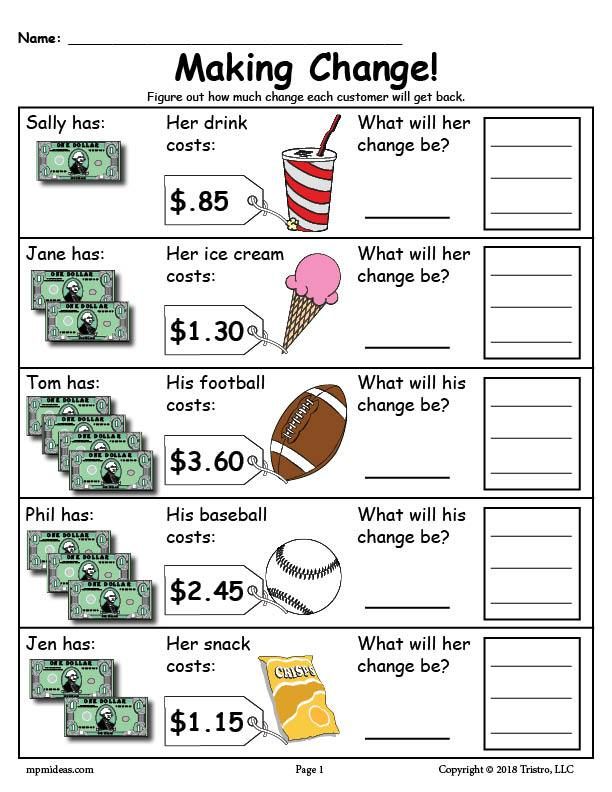 Other children may need a palatal expander before getting braces. A palatal expander creates more room in a child’s mouth, so teeth can come in straight. This will add to the total treatment cost your child will need to straighten their teeth.
Other children may need a palatal expander before getting braces. A palatal expander creates more room in a child’s mouth, so teeth can come in straight. This will add to the total treatment cost your child will need to straighten their teeth.
The following factors can require additional dental or orthodontic visits before your child can be fitted for braces:
- Tooth extraction: To make space for your child’s teeth to come in straight, some teeth may need to be extracted. Tooth extraction is a routine process, but it will require additional visits.
- Palatal expander: A palatal expander actually expands the jaw and creates more room for teeth to come in straight. The jaw is still flexible in children, so this process is easier at a young age. However, this process may take three to six months.
- Tooth decay treatment: If your child has tooth decay, damaged teeth or other dental health problems, these must be resolved before any type of braces will be effective.
 Depending on the damage, this may require one or a few dental visits, and perhaps treatment with antibiotics.
Depending on the damage, this may require one or a few dental visits, and perhaps treatment with antibiotics.
What is the Process for Getting Braces?
Once they have braces, some children may only need to wear them for a year, while others will need more time. The arrangement of your child’s teeth and their bite will determine how long they should wear braces. In general, children tend to wear braces between 18 and 24 months.
To help understand the cost of braces for kids, it’s helpful to know how the process of applying braces works, and what to expect. As previously mentioned, there are different kinds of braces, the process behind each of these varies slightly.
The first step in getting braces is a consultation. At this stage, you, your child and your dentist can discuss the best options for your child’s braces, and estimate the costs. At the next appointment, if no other interventions are needed (see the previous section), your child can get their braces on.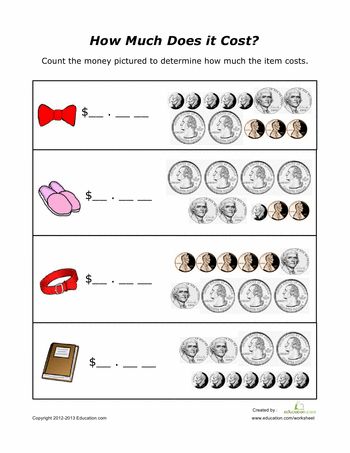 Or, if your child will be using clear aligning trays like Invisalign, the first trays will be fitted.
Or, if your child will be using clear aligning trays like Invisalign, the first trays will be fitted.
Once the braces or trays are fitted, they will continue to realign your child’s teeth for the next 18 to 24 months. Every four to six weeks, your child will need to revisit the dentist so the braces can be tightened, or the trays replaced.
Dental Hygiene Considerations
A child’s dental hygiene will impact how much braces cost. Maintaining good dental hygiene is difficult for many children, and this is harder with braces. Children that exercise good dental hygiene and clean their teeth carefully while they wear braces will benefit from stronger, healthier teeth and they will shorten the time they need braces. Children who are less careful might require extra treatment to prevent gum disease, infection, or tooth decay, and they may need to wear braces longer, incurring more costs.
Here are a few of the ways you can help your child keep their teeth clean before and while they’re wearing braces.
- Brush teeth twice a day every day at the same time
- Floss carefully at night around brackets using dental floss or a water flosser
- Avoid sugary candy and drinks
- See your dentist regularly
- If you use Invisalign, remove the trays when you brush, floss and eat
Cost of Dental Visits
The amount and frequency of visits will depend on your child’s teeth and the type of braces they have. However, the cost of each visit depends on your dentist and your insurance. The cost of each visit will be an especially important consideration if you are paying for braces without dental insurance. To know how much braces will cost for your child, get an estimate of how many visits your child will need and the cost of each visit.
- Location: As with any business, the overhead costs of running a dental or orthodontic office will be higher in bigger cities and busier areas. Therefore, getting braces will be more expensive in these areas.
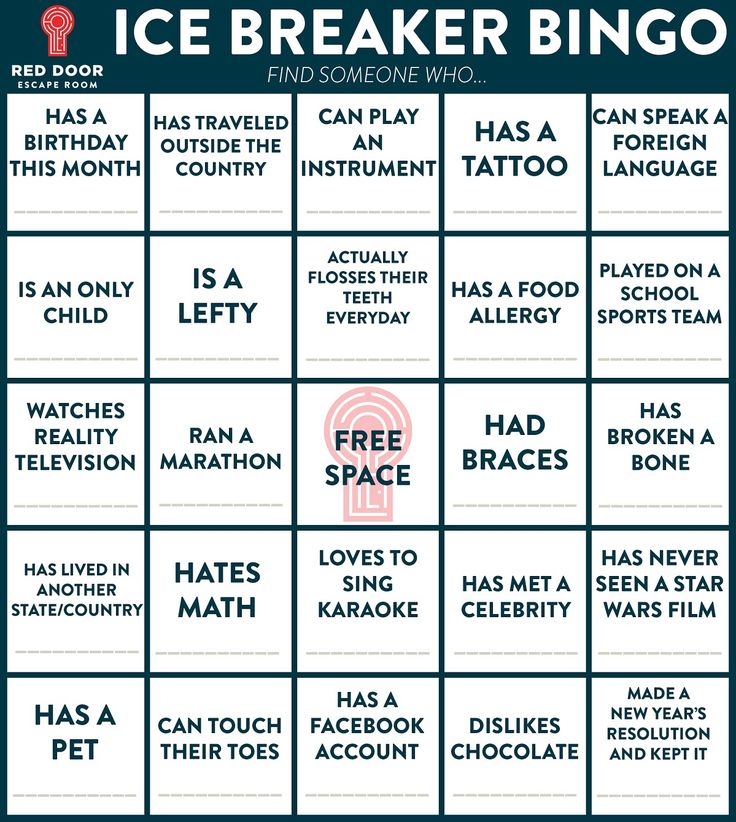
- Teeth complexity: If the arrangement of your child’s teeth is complex, or if they are suffering from tooth decay or other dental problems, the dental visits may also require more complex interventions, and may be more expensive.
- Specialization: If your child needs to see a specialist, such as an oral surgeon, before they can be fitted with braces, or sometime during the process, the cost of dental visits can be more expensive.
- Medication: If your child requires antibiotics to treat a tooth infection, pain medication, or other medicines to make the braces process easier or more manageable, this can also add to the overall cost of braces and dental visits.
Other Financial Considerations
Insurance and FSA
When it comes to how much braces cost, your insurance plan is one of the most important factors to consider. Insurance can cover up to $3,500 of your child’s orthodontic care. The copays, deductible amount, maximum coverage, and type of care covered in your plan will significantly impact the cost of braces. A flexible savings account (FSA) can be used to cover up to $2,550. Before selecting an orthodontic specialist, make sure you fully understand the specifics of your insurance policy and FSA.
A flexible savings account (FSA) can be used to cover up to $2,550. Before selecting an orthodontic specialist, make sure you fully understand the specifics of your insurance policy and FSA.
The following are a few considerations to keep in mind when figuring how much braces cost for kids, and how to budget for braces.
- Double-check your dental insurance: If you have dental insurance, make sure that your dentist or orthodontist accepts it. Dental insurance can significantly help reduce the cost of braces.
- Confirm your insurance details: When working with dental insurance, it’s important to budget for copays and deductibles, and ensure that you know the maximum coverage limits. Read your insurance policy carefully and be sure you understand these aspects of your coverage.
- Look for payment plans: Payment plans can help to make budgeting for braces easier, and reduce interest as you pay off the cost of braces month to month. Ask your dentist about payment plans and compare interest rates.

- Research medical loans: Many banks, credit unions and other lenders offer medical loans to cover medical costs, including dental care. Once again, take a close look at interest rates and the details of the loan to see if this is the right option for you.
- Budget costs: Take a look at our Orthodontic Payment Calculator to get an approximation of your costs. This can help you plan our your budget.
Payment Plans
The right payment plan can make the cost of braces much more manageable. Paying more for your child’s braces up front will reduce the overall cost, but paying for braces in one lump sum is not practical for many families. Ask your orthodontist about the available payment plans and you can make the cost of braces a part of your regular budget. Our handy Orthodontic Payment Calculator can provide you with a reasonable estimate of your payments, depending on how long of a term you choose.
How much braces cost varies greatly, but you can estimate the cost and budget for your child’s braces. Most likely, your child will have braces for at least a year and a half with ten to fifteen orthodontic visits in that time, so it’s a wise financial decision to understand the cost. To get an estimate for your child’s braces, schedule an orthodontic appointment at BDG today.
Most likely, your child will have braces for at least a year and a half with ten to fifteen orthodontic visits in that time, so it’s a wise financial decision to understand the cost. To get an estimate for your child’s braces, schedule an orthodontic appointment at BDG today.
What Is the Average Price for Braces for Kids?
Many parents dread finding out that their child needs braces.
And not for nothing—braces can rank among the heftiest health-related expenses you’re likely to face in the course of raising your offspring.
While it’s true that braces aren’t cheap, advances in dental technology have made them far more accessible to both adult and adolescent patients over the decades. If one of your kids needs braces, it’s possible to take the necessary steps to protect and improve their oral health without saddling yourself with an oversized financial burden.
Average Price for Braces for Kids
The first question on the mind of parents of children with dental issues is usually, “How much do braces cost for kids?”
Unfortunately, there isn’t one definitive answer—the cost of braces is contingent on many factors and can therefore vary widely.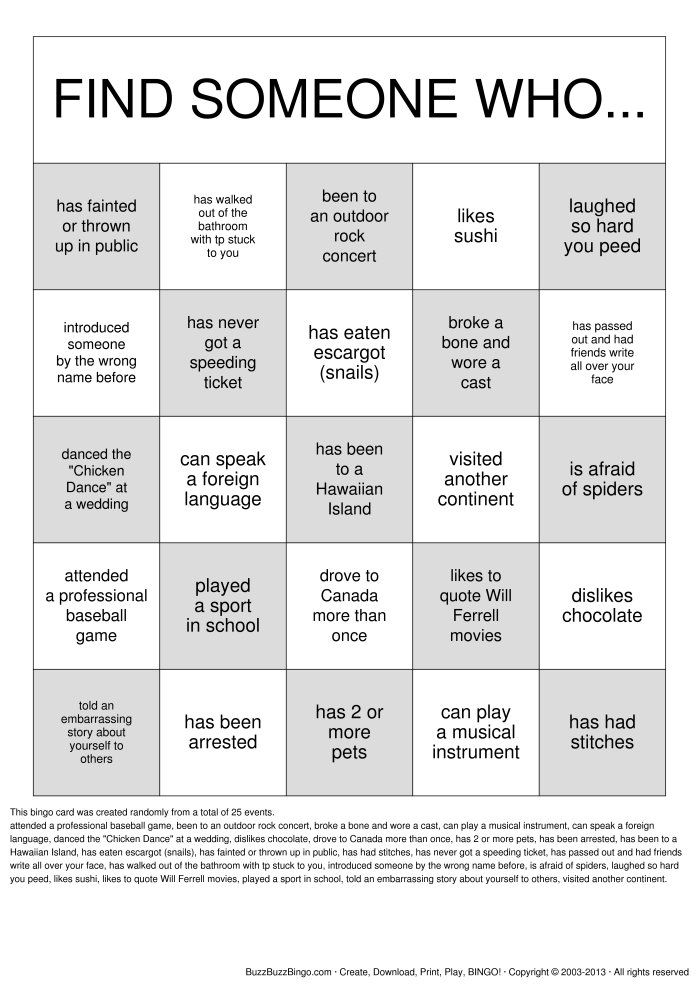
On average, however, putting braces on your child will run you somewhere between $3,000 and $7,000. Those figures reflect the time, materials, labor, and expertise involved in carrying out the necessary treatment and are subject to increase depending on the type of braces you or your child’s orthodontist recommend.
Types of Braces
You might not know it, but “braces” is actually an umbrella term that can refer to a number of teeth-straightening solutions. There’s more than one way to ensure that your child’s teeth grow straight and strong, and the method you choose will play a big part in determining what you end up paying.
Standard Metal Braces
Metal braces consist of wires and brackets arranged to hold the teeth in a fixed position. They’re what most people picture when they think of braces.
Traditional metal braces are affordable, effective, and quick to produce results, but they tend to be more conspicuous than other solutions due to their all-metal construction.
Ceramic Braces
Ceramic braces are virtually identical to metal braces, only made with (you guessed it) ceramic. The strong, light-colored material blends in with the patient’s teeth and doesn’t cause pain or irritation the way a mouth full of metal can.
Because of these virtues, ceramic braces can be considerably more expensive than metal braces.
Lingual Braces
Lingual braces are metal braces that attach to the lingual (tongue) edge of the teeth. They offer all the benefits of standard metal braces with the additional perk of being hidden by the teeth themselves.
They also have a couple of downsides. For one, they cost an average of $1,000-2,000 more than front-facing braces. And since their placement can interfere with the movement of the tongue during speech, they sometimes cause the wearer to talk with a slight lisp.
Alternatives to Braces
Heavy-duty hardware isn’t always the answer, particularly if your goal is to fix gaps and similar minor cosmetic imperfections. Other teeth-straightening solutions exist that may offer parents a simpler and more cost-effective alternative to traditional braces.
Other teeth-straightening solutions exist that may offer parents a simpler and more cost-effective alternative to traditional braces.
Invisalign
The Invisalign system makes use of hard plastic tray-style aligners that are molded to the patient’s teeth. These trays are transparent, making it hard to tell that the wearer has anything covering their teeth at all.
Invisalign is priced similarly to traditional braces treatments, but they come with a hidden cost—inconvenience.
The aligners must be continually replaced every 1-2 weeks to keep the teeth moving into the desired position. However, that might be a little too frequent for some parents, especially when compared with conventional braces, which only require adjusting every 4-6 weeks.
At-Home Teeth Straightening Kits
These products are essentially the over-the-counter answer to Invisalign.
These sorts of DIY solutions can be useful for patients whose teeth don’t require dramatic correction or aren’t willing or able to pay the full price for Invisalign.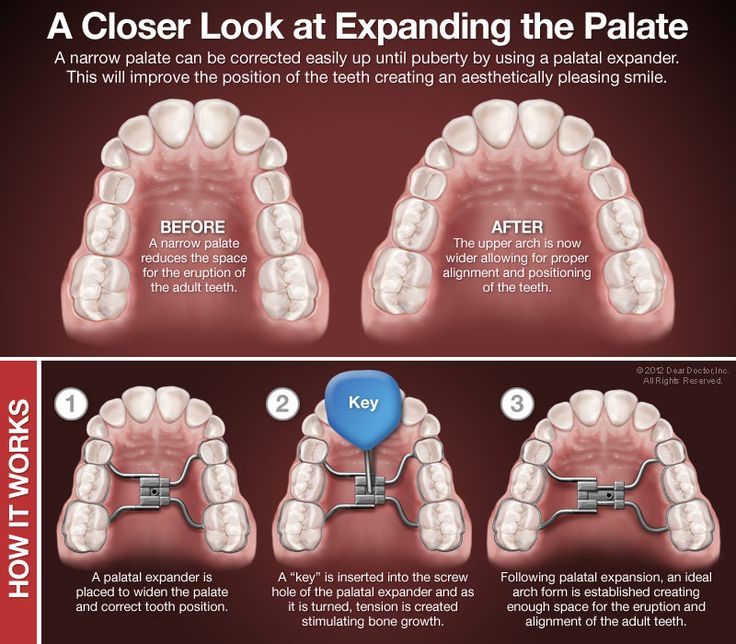 That said, they don’t work as well as the prescription version, despite costing almost the same amount in many cases.
That said, they don’t work as well as the prescription version, despite costing almost the same amount in many cases.
Does Insurance Cover Braces?
This is another question that doesn’t have a one-size-fits-all answer.
Many dental insurance plans will at least partially cover the cost of braces for children under 18, so long as an orthodontist recommends them. Exact rates differ between providers, but companies who do offer coverage typically put up 50% or more of the total cost of the treatment.
It’s important to note that this coverage usually only applies to standard metal braces. If you or your child opt for a different style, you may have no choice but to pay the difference out of pocket.
What Affects the Average Price of Braces for Kids
Aside from the different styles and materials mentioned above, the biggest factor as far as the affordability of your child’s braces is the length of time they have to wear them.
Fortunately, youngsters don’t tend to require the corrective benefits of braces for as long as adults. Most kids are out of braces within 16-24 months of their initial installation.
Most kids are out of braces within 16-24 months of their initial installation.
Other Factors That Impact The Cost of Braces
Any of the following conditions could potentially increase or decrease the overall expense associated with getting braces for your child:
- Their age
- Their specific dental needs
- Your orthodontist’s experience level
- Your orthodontist’s individual rates
- The average cost of living in your area
How To Keep Orthodontics Costs Down
There are several strategies that savvy parents can employ to minimize the cost of braces. Here are just a few:
- Go with standard metal braces. As mentioned, traditional metal braces are generally the most affordable and readily available teeth-straightening solution out there.
- Ask your orthodontist what kind of financing plans they offer. A financing plan will allow you to pay for your child’s treatment over time in small, affordable installments.
 Children’s Dental FunZone offers multiple financing options so that parents can pay in whatever way works best for them.
Children’s Dental FunZone offers multiple financing options so that parents can pay in whatever way works best for them. - Check to see if your family Medicaid plan covers braces. Medicaid, like private insurance, will often pay at least a portion of the cost of your child’s new braces.
Conclusion
For more information about braces and the costs that come with them, book a free consultation at any of great locations. One of our experts at Children’s Dental FunZone would love to see you and answer any of your questions. We’re in the business of smiles and always treat your child as if they were our own!
| Service name | Price/rub |
| Orthodontic correction with braces: TRG | analysis1800 |
Orthodontic correction with braces: treatment planning with braces based on the analysis of TRH, CT, plaster models, photo protocol. | 6000 |
| Orthodontic correction using braces: Damon metal self-ligating braces, h5 for one jaw during the promotion period | 51500 |
| Orthodontic correction using braces: Damon ceramic self-ligating braces for one jaw during the promotion period during the promotion period | 73000 |
| Orthodontic correction using braces: metal ligature braces for one jaw during the promotion period | 25000 |
| Orthodontic correction with braces: ceramic ligature braces for one jaw during promotion | 30300 |
| Orthodontic correction using braces: re-fixation of one bracket without bracket cost | 1000 |
| Orthodontic correction with braces: ceramic bracket without installation cost | 4000 |
| Orthodontic correction using braces: metal bracket without installation cost | 3500 |
| Orthodontic correction with braces: re-appointment within the framework of the developed orthodontic treatment plan on braces without changing wires | 3000 |
| Orthodontic correction with braces: re-appointment within the framework of the developed plan of orthodontic treatment on braces with change of wires | 6000 |
| Orthodontic correction with braces: button fixation | 1000 |
| Orthodontic correction with braces: installation of a torque spring | 3000 |
| Orthodontic correction with braces: installation of opening/closing spring | 2000 |
| Orthodontic correction with braces: bite separation with occlusal linings | 1600 |
| Orthodontic correction with braces: removal of the braces from one tooth and preparation of the tooth surface | 600 |
| Orthodontic correction using braces: installation of a retainer on one dentition | 10000 |
| Orthodontic correction with braces: removal of the retainer from the surface of one tooth | 800 |
| Orthodontic correction with braces: one tooth retainer correction | 1200 |
| Orthodontic appliance services: retention plate | 8000 |
| Dental prosthesis manufacturing services: mouth guard manufacturing | 5000 |
| Orthodontic correction with fixed orthodontic appliance "Forsus" | 33000 |
| Orthodontic correction using braces: 2x4 ligation bracket system (1 jaw) | 17000 |
Removal, placement of crowns, orthodontic rings (1 pc. ) ) | 5000 |
| Orthodontic appliance services: indirect fixation of the bracket system (1 jaw) | 6000 |
| Orthodontic appliance services: separation ring installation | 350 |
| Making a simple plastic tooth for orthodontic treatment | 2000 |
| Plate apparatus | |
| Orthodontic services: expansion plate with one screw | 21000 |
| Orthodontic services: expansion plate with two screws | 21000 |
| Orthodontic appliance service: expansion plate with Bertoni screw | 24000 |
| Orthodontic appliance services: repeat plate | 18000 |
| Orthodontic services: Twin block | 48000 |
| Orthodontic appliance services: Frenkel appliance | 48000 |
| Orthodontic appliance services: fixed rapid palatal expansion appliance (Haas appliance, Marco Rosa) | 38000 |
| Orthodontic Appliance Services: Trainer | 21000 |
| Production of vestibular plate | 12000 |
| Making an orthodontic ring | 10000 |
| Orthodontic appliance services: plate correction | 1200 |
| Orthodontic Appliance Services: Appliance fitting | 3000 |
| Orthodontic appliance repair: orthodontic appliance repair | 7000 |
| Aligners | |
| Aligner fabrication: 3D modeling | 40000 |
| Aligner fabrication: mouthguard treatment (incomplete set) | 192000 |
| Aligner fabrication: mouthguard treatment (complete set) | 288000 |
| Aligner fabrication: mouth guard treatment (complex, complete set) | 348000 |
| Aligner fabrication: using "Invisalign" aligners incomplete case (up to 20 kappas) | 312000 |
| Aligner fabrication: using Invisalign aligners full case (up to 50 kappas) | 444000 |
Braces for children in St.
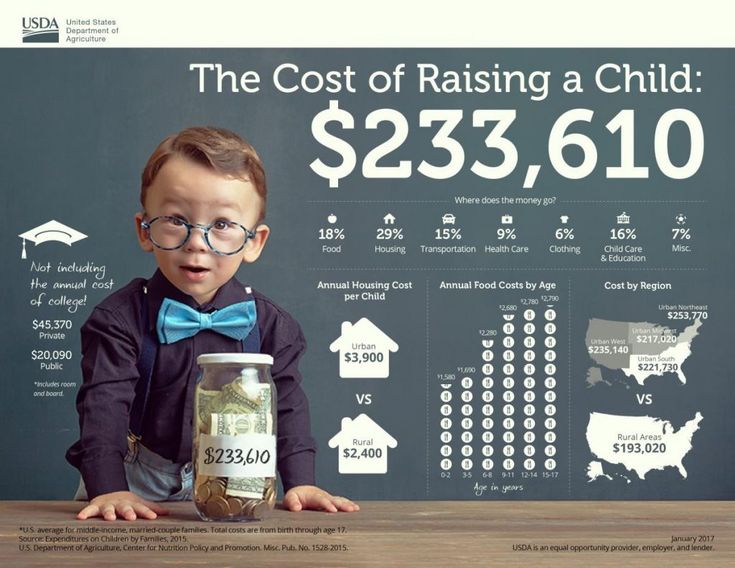 Petersburg
Petersburg Publication date: June 28, 2021.
Date of updating information on the page: September 21, 2022.
Everyone has probably heard the phrase “bracket system”. And one of the most common opinions is that it is used only in adults or adolescents. Let's see if this is the case.
Bracket system is a non-removable device consisting of locks fixed on each tooth and wires passing through these locks. If necessary, such a system has additional elements: springs, chains, buttons, etc. This type is really installed only for adults and adolescents, when all permanent teeth have already erupted.
But there is a special type for the smallest patients - this is partial braces . It is also called apparatus 2x4 , since such a system is placed on 4 permanent incisors and 2 permanent molars with an arc and additional elements: springs, chains. Partial braces can be installed on one jaw (usually on the upper one), or on both, depending on the necessary treatment tasks.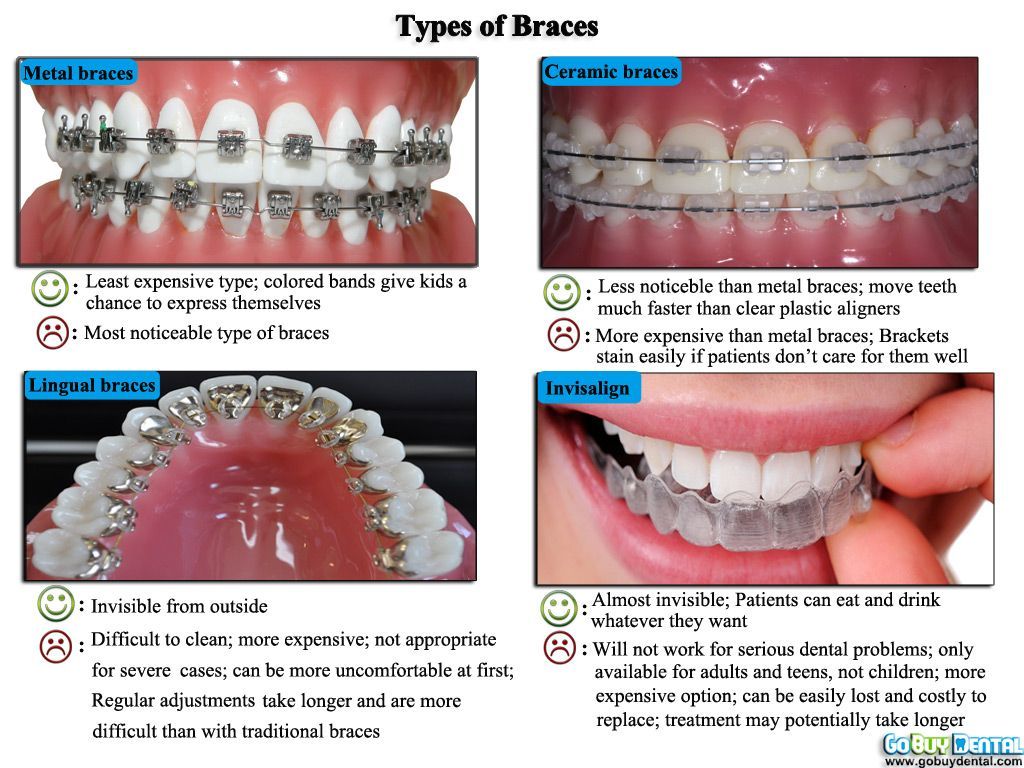
To start treatment in children, two permanent molars and four incisors must erupt in one jaw, which most often corresponds to ages 7-9 . The rest of the teeth may be milk or in the process of loss and eruption of permanent teeth.
What kind of braces are given to children?
Children are fitted with the same braces as adults - they can be ligature or self-ligating, metal or transparent.
Ligature are brackets without a cap, in which the wire is held by special elastic rings (ligatures).
Self-ligating have a cap and the wire is tightly fixed in a closed bracket without ligatures.
Both types can be transparent and metal , however, children are more likely to install metal ones - they are less fragile, which minimizes breakdowns in active children and reduces the number of unscheduled visits to the doctor.
The advantage of self-ligating is the absence of additional rubber bands in the system, which accumulate plaque and complicate hygiene for a small patient.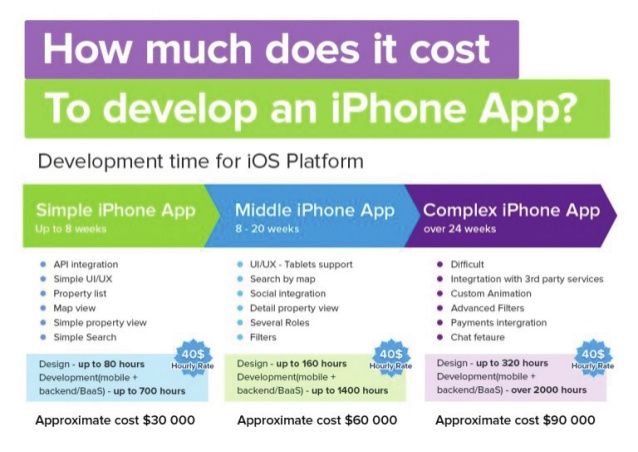 And the main advantage of ligatures is that the rubber bands that hold the arch can be not only transparent, but also colored - for kids, choosing the color of the rubber bands on the braces at each visit can be an excellent motivation for treatment.
And the main advantage of ligatures is that the rubber bands that hold the arch can be not only transparent, but also colored - for kids, choosing the color of the rubber bands on the braces at each visit can be an excellent motivation for treatment.
Indications for partial braces.
Partial braces are installed in children aged 7 to 10 years in the following cases:
How is the installation?
There are 2 types of bracket fixation:
- Direct - brackets are fixed one at a time directly behind the teeth.
- Indirect - braces are transferred to the entire dentition at once from an individual cap.

For children, braces are installed in a direct way, since indirect fixation requires additional manipulations (removal of impressions), and erupting teeth can cause a poor fit of a portable mouthguard and worsen fixation.
The procedure for installing partial braces takes from 15 to 30 minutes:
- The little patient sits comfortably in the chair and puts on special goggles from the bright light of the dental lamp.
- The doctor installs a plastic frame that pushes back the lips and cheeks, creates a good view and prevents saliva from entering the surface of the teeth.
- A purple or blue gel is applied to the outer surface of the permanent incisors and molars for a few seconds - the gel prepares, disinfects the tooth enamel and improves the fixation of the brackets. Next, the gel is thoroughly washed off with water, and the tooth surface is dried.
- Next, the doctor installs a bracket with fixing material on the tooth, checks its position, and illuminates it with a special lamp for several seconds.
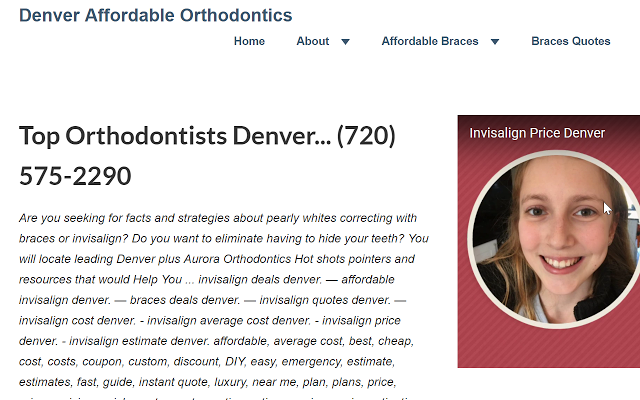
- After installation, the doctor removes the plastic frame, rinses all teeth with water and sets the orthodontic archwire. Orthodontic treatment has begun!
How often do you need to visit the orthodontist and how long does the treatment last?
Treatment with partial braces takes 8-10 months on average. During this time, all the main tasks are solved and conditions are created for the correct formation of the dentition - the incisal overlap is improved, a place is created for the eruption of permanent teeth and crowding is eliminated. You need to visit the orthodontist regularly every 1.5-2 months.
Advantages
Children's braces are installed on the teeth for the entire duration of treatment, they cannot be removed on their own.
This is one of the biggest advantages of this system, since the treatment is continuous (if you do not miss scheduled visits to the orthodontist). A great difficulty in the treatment of children with removable plates or aligners is the dependence of treatment on cooperation with the patient and his parents.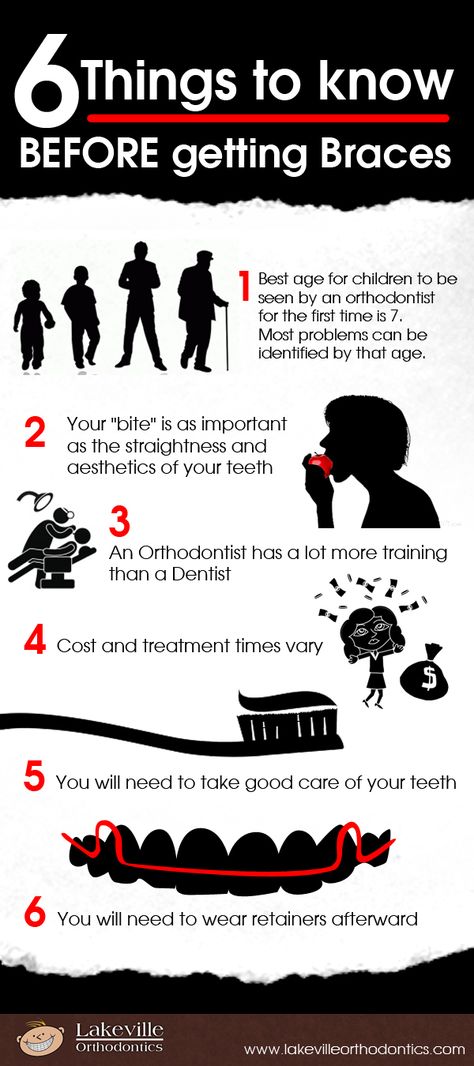 The result depends on how well the child wears the plate. In addition, removable devices do not always have the technical ability to solve a number of orthodontic problems, in contrast to the bracket system.
The result depends on how well the child wears the plate. In addition, removable devices do not always have the technical ability to solve a number of orthodontic problems, in contrast to the bracket system.
When treated with aligners, in addition to issues of cooperation and regular wear, another feature arises. Aligners are made individually according to the initial scans of the teeth, but in children at this age, permanent teeth begin to erupt - the aligners may no longer “fit”. In this case, re-scanning and the manufacture of new caps are carried out.
Disadvantages
Disadvantages of orthodontic treatment are associated with the young age of patients. This refers to the possible occurrence of dental caries and poor hygiene due to lack of motivation for good brushing and undeveloped manual skills. Orthodontists, dentists and hygienists pay great attention to the level of hygiene - each visit is monitored and, if necessary, professional hygiene and supervised brushing lessons .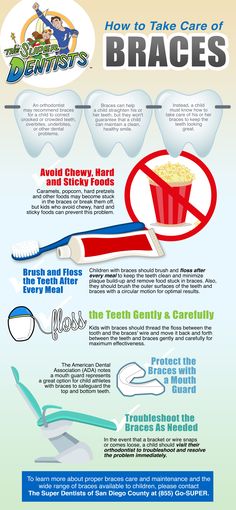 Lessons help parents and children understand the importance of good home hygiene and develop the necessary manual skills.
Lessons help parents and children understand the importance of good home hygiene and develop the necessary manual skills.
According to our protocol, children have regular check-ups at the dentist, attend quarterly cleanings with applications of calcium and fluoride preparations - all this minimizes the risk of caries during this period.
How are braces removed for children?
The removal procedure, as well as their installation, is quite fast - up to 30 minutes. The orthodontist, using a special tool, grabs the bracket and gently snaps it off the tooth. The process is painless, but the child may feel some pressure on the tooth when the bracket is peeled off. Next, with the help of a polishing gum, the remnants of the fixing material are removed from the surface of the tooth.
What are the alternatives?
For some orthodontic problems in children, the following can also be used:
- children's aligners
- removable plates
The main disadvantage of removable appliances is that the child may not wear it or lose it, and then the effectiveness of treatment will be low.
Is additional orthodontic treatment required as an adult?
In most cases, partial braces are sufficient to avoid repeat treatment during adolescence. However, in case of a serious pathology, when the jaw is too small and the teeth are large, it is possible to repeat the treatment on the bracket system, but with the support of all permanent teeth. Treatment in childhood is called the first stage of orthodontic treatment, and after the eruption of all permanent teeth during active growth, the second stage begins.
Complete braces for children aged 11-14. This is the best time when you can solve almost all pathologies of the dentoalveolar system (with the exception of those cases that clearly require maxillofacial surgery). At this age, using the active growth of children, we can correct severe crowding without removing teeth, stimulate the growth of the lower jaw, and correct malocclusion.
Author of the article: Petrova Elena Aleksandrovna
Orthodontist
Cost of braces for children
| Orthodontist consultation | RUB 1,000 |
| Orthodontic diagnostics | From 7 500 rubles.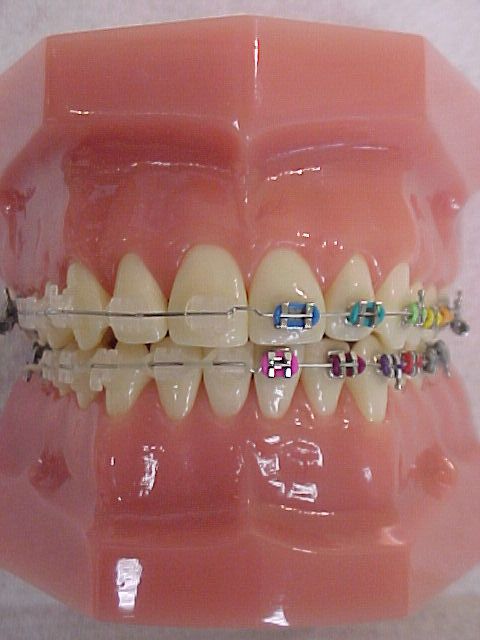 |



